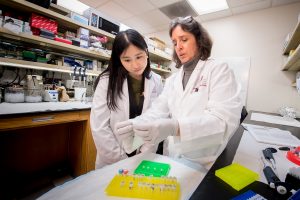
The International Pediatric Adrenocortical Tumor Registry is a database for young patients afflicted with these rare tumors. The result has created more personalized and targeted care as well as benefited the patient’s families and their physicians.
Last October, the Journal of Clinical Oncology published a paper that described the clinical features and outcomes in children with adrenocortical tumors (ACTs) without germline TP53 mutations, by Emilia Modolo Pinto, PhD, of St. Jude’s Children’s Research Hospital in Memphis, Tenn., et al. Pediatric ACTs are cancers associated with germline mutations in the TP53 tumor suppressor gene, but the authors of the paper point out that these tumors are also rarely associated with genetic constitutional disorders like Beckwith-Wiedemann syndrome (BWS), and that approximately half of children with ACTs don’t actually have TP53 germline mutations, and the tumorigenesis and tumor progression in these children are not well understood.
The results of that study show significant overlap of clinical features and prognostic factors in children with and without germline TP53 mutations. There are differences between these two groups as well. The results allow Pinto and her team to be able to point to other factors that should be considered in children with ACTs, like constitutional abnormalities of the chromosome 11p15, and recommend the protein Ki-67 LI be included in order to improve the risk classification of pediatric ACT.
This significant find was made possible by the International Pediatric Adrenocortical Tumor Registry (IPACTR) at St. Jude’s Hospital. The registry was established 28 years ago with the goal of creating a database repository of the clinical and demographic features, treatment modalities, and outcomes of children and adolescents with ACTs, as well as perform molecular analysis of tumors and blood from those patients to clarify the mechanisms of adrenocortical tumorigenesis and provide consultation and recommendations for the management of ACTs in pediatric patients.
Addressing a Knowledge Deficit

The motivation for creating the IPACTR came from the observation of a cluster of pediatric ACTs in southern Brazil, according to Raul Ribeiro, MD, a pediatric hematologist/oncologist at St. Jude’s. ACTs represented two to three percent of pediatric cancer each year in the pediatric oncology unit of a hospital in Curitiba, Brazil. Some families saw two or more of their children develop ACTs.
“… about 50% of children with ACTs carry a germline TP53 mutation, irrespective of the tumor size and histology. Therefore, collaborations between endocrinologists and IPACTR investigators would facilitate discussions about the management of these tumors and provide information for parents and relatives.” – Emilia Modolo Pinto, PhD, St. Jude’s Children’s Research Hospital, Memphis, Tenn.
“At the time, published information regarding the management of these tumors and counseling of the families was virtually nonexistent; the most popular pediatric oncology compendium included less than a page about ACT,” Ribeiro says. “Therefore, St. Jude and Brazilian investigators began collaborating to address the lack of knowledge about pediatric ACT in general and to understand the causes of the pediatric ACT cluster in Brazil. We reasoned that a registry for this rare tumor that was open to the entire international community would enable enough cases to be collected to address the lack of knowledge concerning this disease.”
Here’s how it works: When physicians, healthcare providers, or parents ask St. Jude physicians about how to manage a child’s ACT, they are invited to participate in the IPACTR. The tumor is histopathologically reviewed and then genetic counseling is offered to the patient and relatives if patient is TP53-positive. All of this is free of charge.

“In summary, the registry offers the opportunity to collect clinical and demographic information, the family history of cancer, laboratory information, details of treatment practices, and outcome data for children and adolescents with adrenocortical tumors,” Pinto says. “Biological material, including tumor and blood samples from the patient and their relatives, allows us to perform collaborative investigations to understand the biology of the disease and ultimately improve the outcomes for these patients.”
There are about 400 patients from around the world currently enrolled in the IPACTR. Pinto says that parents will call and discuss doubts and new developments in the family. “Often, concerns regarding the long-term complications of chemotherapy or of early exposure to virilizing hormones are discussed,” she says.
Pinto is part of a multidisciplinary team that analyzes and interprets the clinical, imaging, molecular, genetic, and histopathologic data to help in treatment decisions for each patient. She attends conferences around the world and has authored several papers in the field. When asked about a typical day working at the IPACTR, she exclaims that there’s no such thing. “Each day is different and is usually split between laboratory work, which includes routine molecular and genetic assays, as well as designing and performing specific DNA-based tests according to the genetic profile of the patient that will improve the accuracy of diagnosis, and time spent in research,” she says. “I’m involved in several projects to elucidate the molecular mechanisms operating in pediatric ACT cells.”
“The most exciting part of being involved in the IPACTR is the opportunity to do research and learn more about this rare disease and contribute to helping our little patients,” Pinto continues.
Multidisciplinary Collaboration
And it’s because of that rarity that each case counts. Pinto says that even a small ACT with a “benign” histology that’s completely resected might hide a TP53 mutation. Patients with ACTs are usually referred to an endocrinologist before an oncologist, in contrast to most other pediatric tumors, since small ACTs are often associated with endocrine manifestations and do not exhibit mass effect. A surgeon removes the tumor and diagnosis is established by histopathology. Pinto says pediatric oncologists are called in for large tumors or metastasis. “The problem with this approach is that about 50% of children with ACTs carry a germline TP53 mutation, irrespective of the tumor size and histology,” she says. “Therefore, collaborations between endocrinologists and IPACTR investigators would facilitate discussions about the management of these tumors and provide information for parents and relatives.”

The IPACTR was instrumental in Pinto and her team demonstrating that there are at least two distinct pathways in pediatric adrenocortical tumorigenesis: TP53 mutations and chromosome 11 abnormalities. Patients with TP53 mutations develop tumors that grow rapidly and accumulate many genomic changes. The tumorigenesis in patients with BWS or other chromosome 11 abnormalities includes overexpression of IGF-2, inducing the proliferation of embryonal adrenal cortex cells. The tumor develops through a mutation in beta-catenin.
“In some cases, there may be a somatic TP53 mutation, resulting in faster tumor growth and increased potential for metastasis. These biological insights are correlated with outcome information available in the IPACTR, resulting in more rational recommendations for children with newly diagnosed ACTs.” – Emilia Modolo Pinto, PhD, St. Jude’s Children’s Research Hospital, Memphis, Tenn.
“The accumulation of genomic changes in these cases is very slow; patients can have large tumors without distant metastasis, and these tumors can be managed with surgery alone,” Pinto says. “However, in some cases, there may be a somatic TP53 mutation, resulting in faster tumor growth and increased potential for metastasis. These biological insights are correlated with outcome information available in the IPACTR, resulting in more rational recommendations for children with newly diagnosed ACTs.”
This finding means there could more targeted approaches to treating ACTs in these pediatric patients since they have the opportunity to have their tumors analyzed in detail, as well as receive genetic counseling and surveillance for carriers. “Enrollment in the protocol would not cause extra work for the attending physician, because the informed consent is obtained by phone directly from parents. St. Jude is the [institutional review board] of reference,” Pinto says.
“We hope that our experience will stimulate colleagues to develop models to study other rare pediatric diseases,” she continues.
— Bagley is the senior editor of Endocrine News. He wrote about provider bias in recommending weight loss surgery for younger patients in the July issue.

